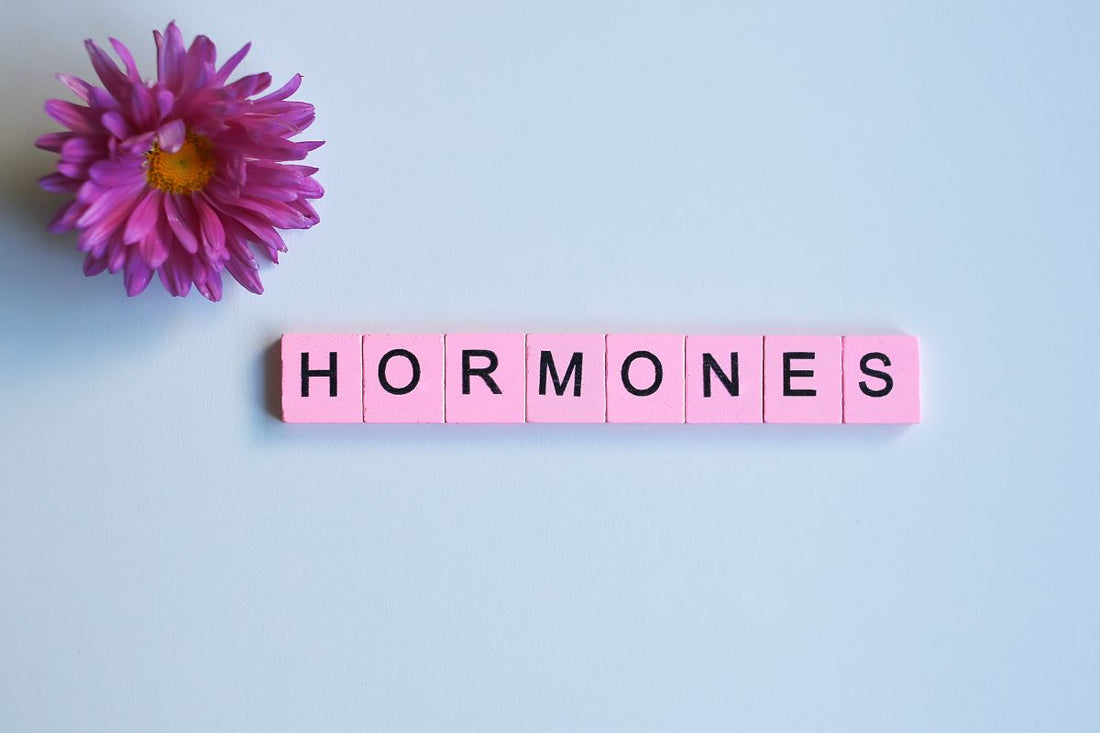Most people think of hormone balance as something affected by food, sleep, and stress. And while that’s all true, there’s a lesser-known culprit silently throwing your endocrine system off-balance every single day: your personal care and clothing products.
From the shampoo in your shower to the synthetic fabrics in your activewear, many of the products we use daily contain compounds that interfere with our hormones. These hidden disruptors—often unregulated or poorly labeled—can accumulate over time, leading to fatigue, mood swings, infertility, weight gain, and even chronic disease.
In this blog, we’ll break down the biggest hormone disruptors hiding in your closet and bathroom, the science behind how they affect your body, and simple swaps you can make today to detox your environment.
What Are Hormone Disruptors?
Hormone disruptors (also called endocrine-disrupting chemicals, or EDCs) are substances that interfere with the body’s natural hormone signaling. They can mimic, block, or alter the production of essential hormones like estrogen, testosterone, cortisol, and thyroid hormones.
The problem? These chemicals are everywhere—in plastics, skincare, fragrances, laundry detergent, clothing dyes, and even "clean" beauty products. And because they act in extremely small doses, even low-level, chronic exposure matters.
1. Synthetic Fragrances: A Hidden Cocktail of Toxins
If you see the word "fragrance" or "parfum" on a label, you’re looking at a black box of potentially hundreds of undisclosed chemicals. Many of these are phthalates, a class of plasticizers used to make scents last longer. Phthalates are well-documented hormone disruptors that have been linked to:
-Lower testosterone
-Infertility in men and women
-Altered fetal development
-Increased risk of obesity and metabolic dysfunction
Where they hide:
-Shampoo, conditioner, body wash
-Laundry detergent and dryer sheets
-Deodorants and perfumes
-Air fresheners and candles
What to do: Look for products labeled "fragrance-free" or "scented with essential oils." Third-party certifications like EWG Verified or MADE SAFE are helpful.
Our top pick for deodorant: EO Essential Oils

2. Parabens and Preservatives
Parabens are a class of preservatives used to prevent bacterial growth in personal care products. They also happen to mimic estrogen in the body and have been found in breast tissue and tumors.
Linked to:
-Estrogen dominance
-Breast cancer
-Reproductive toxicity
Where they hide:
-Lotions, face creams
-Sunscreens
-Shaving creams
-Makeup
What to do: Look for labels that say "paraben-free" and check for ingredients ending in -paraben (like methylparaben or butylparaben).
Our top pick for sunscreen: Native Mineral Sunscreen
3. BPA and Plastics
Bisphenol A (BPA) is a synthetic estrogen used in plastics and resin linings. While most people associate BPA with food containers, it’s also a problem in your bathroom.
Linked to:
-Insulin resistance
-Fertility issues
-Increased estrogen and decreased testosterone
Where they hide:
-Plastic packaging for skincare and cosmetics
-Hairbrushes and razors
-Feminine hygiene product applicators
What to do: Opt for products packaged in glass or metal. Don’t store personal care products in plastic, especially in warm or sunny areas.

4. Synthetic Fabrics in Clothing
That pair of yoga pants might look sleek and feel comfy, but if it’s made with polyester, nylon, or acrylic, it likely contains endocrine-disrupting chemicals from:
-Fabric dyes
-Flame retardants
-PFAS (used for stain- and water-resistance)
Linked to:
-Disruption of thyroid and sex hormones
-Increased body burden of toxicants
-Skin irritation and long-term exposure risks
What to do: Choose natural fibers like organic cotton, hemp, wool, or bamboo. Wash new clothes before wearing and avoid "wrinkle-resistant" or "waterproof" items unless they’re certified non-toxic.

5. Heavy Metals in Makeup and Skincare
Lead, cadmium, arsenic, and mercury have been found in everything from lipstick to eyeliner. These metals can accumulate in the body and interfere with hormone production and function.
Linked to:
-Thyroid dysfunction
-Reproductive harm
-Mood disorders
Where they hide:
-Lipsticks, especially darker shades
-Eyeliners and eyeshadows
-Bright-colored blushes and powders
What to do: Stick with brands that do third-party heavy metal testing. Avoid imported, non-certified cosmetics and overly pigmented products.
Our top pick for makeup and skincare: Well People
6. Antibacterial Agents Like Triclosan
Triclosan is a powerful antimicrobial that was once common in hand soaps and toothpaste. Although it’s been banned from some uses, it still shows up in other products.
Linked to:
-Thyroid hormone disruption
-Gut microbiome imbalance
-Increased risk of allergies and asthma
Where they hide:
-Toothpaste
-Deodorant
-Shaving cream
-Hand sanitizers
What to do: Avoid products labeled “antibacterial.” Use simple soap and water or natural sanitizers with ethanol or isopropyl alcohol.
Our top pick for toothpaste: Primal Life Tooth Powder

7. Laundry Detergents and Fabric Softeners
What you wash your clothes in ends up on your skin all day long. Many conventional detergents contain:
-Synthetic fragrances
-Optical brighteners
-Quaternary ammonium compounds (quats)
Linked to:
-Skin irritation
-Hormonal imbalance
-Endocrine disruption from long-term exposure
What to do: Switch to unscented or naturally scented detergent, ideally one with EWG Verified status. Avoid dryer sheets altogether and use wool dryer balls instead.
Our top pick for laundry detergent: Zum Laundry Soap
The Cumulative Effect
Individually, these exposures might seem small. But together, they create a constant hormonal assault on your body. Your skin is your largest organ, and it absorbs what you put on it. Couple that with synthetic clothing and household chemicals, and it becomes clear why detoxing your environment is just as important as cleaning up your diet.
How to Detox Your Closet and Bathroom
You don’t need to throw everything out overnight. But small, consistent swaps go a long way. Here’s a quick roadmap:
Start With What You Use Most:
-Replace body lotion, face cream, and deodorant with clean versions
-Choose unscented or essential oil-based shampoo and body wash
-Swap plastic razors and makeup containers for stainless steel or glass
Clean Out Your Closet:
-Choose natural fibers when buying new clothes
-Wash synthetics with a microfiber-catching bag (like a Guppyfriend)
-Avoid stain-resistant or wrinkle-free treatments unless verified safe
Rework Your Laundry Routine:
-Use non-toxic detergent and wool dryer balls
-Avoid fabric softeners and dryer sheets
-Wash clothes before first wear to remove factory chemicals
Simplify Your Beauty Routine:
-Use fewer products with fewer ingredients
-Look for transparency in labeling and third-party testing
-Prioritize clean makeup for products used near eyes and mouth
Final Thoughts
Hormone health isn’t just about what you eat or how much you sleep. It’s also about what your body is absorbing through the skin every single day. By becoming more aware of the hidden disruptors in your closet and bathroom, you empower yourself to take control of your hormonal balance, energy, and overall health.
Your hormones are constantly working for you—regulating your mood, metabolism, fertility, and more. Show them the respect they deserve by choosing products that support, not sabotage, their function.
Looking for an easy way to fuel your clean lifestyle? Hunghee Energy is crafted without seed oils, synthetic additives, or processed sugars. Made with grass-fed ghee, raw honey, and ancient sea salt—our animal-based snacks are clean, energizing, and designed to fuel you naturally.
Fuel your body. Honor your biology. Choose wisely.
Hunghee Ancestral Energy is grounded in primal nutrition—packed with the most bioavailable animal-based nutrients and fueled by fat for performance, clarity, and adventure. Whether you're chasing peaks, hitting the gym, or just managing the chaos of everyday life, Hunghee's 1oz on-the-go packs deliver clean-burning, fat-fueled energy rooted in evolutionary wisdom. Made with organic grass-fed ghee, local raw honey, and ancient sea salt, Hunghee is fuel the way nature intended.
Disclaimer: This content is for informational purposes only and is not intended as medical advice. Please consult your healthcare provider for advice about a specific medical condition or before starting any new fitness or nutritional program.

